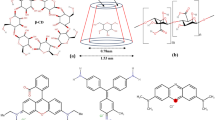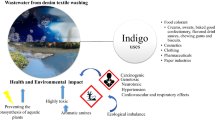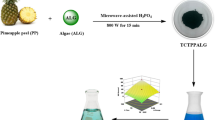Abstract
Textile is one of the most important sectors generating large volume of liquid pollutants. Hence, one of the great challenges is to design effective adsorbent to treat wastewaters prior to their discharge in water streams. This study emphasizes the use of microorganisms for the treatment of recalcitrant and toxic dyes being caused by textile industries. For this aim, the azo dyes of Reactive Red 3, Reactive Yellow 42, Reactive Black 5, Reactive Blue 4 and Acid Orange 74, which are extensively used in textile industry, were treated by dispersed Aspergillus niger. Decolorizing of basic dyes was successful at higher pH values, while acid dyes’ removal was possible only at low pH values. Removal efficiency after 24 h incubation for R. Red, R. Black and R. Blue reached to 95% in batch process. FTIR analysis of 24-h treatment showed change in peaks when compared to control dye spectra indicating biodegradation of dyes after treatment. Then, the fungi were embedded in polyhydroxyethyl methacrylate-glycidyl methacrylate [poly (HEMA-co-GMA)] to fabricate bio-composite columns. Removal of color and reduction of chemical oxygen demand (COD), biological oxygen demand, total dissolved solids, total solids and total organic carbon of industrial textile effluent were studied through the bio-composite column. COD reduction and color removal of textile effluents were 77.5% and 99.2%, respectively.






Similar content being viewed by others
References
Ali N, Hameed A, Ahmed S (2010) Role of brown-rot fungi in the bioremoval of azo dyes under different conditions. Braz J Microbiol 41:907–915
Alvarez GS, Foglia ML, Camporotondi DE, Tuttolomondo MV, Desimone MF, Diaz LE (2011) A functional material that combines the Cr(VI) reduction activity of Burkholderia sp. with the adsorbent capacity of sol–gel materials. J Mater Chem 21:6359–6364
Andleeb S, Atiq N, Robson GD, Ahmed S (2012) An investigation of anthraquinone dye biodegradation by immobilized Aspergillus flavus in fluidized bed bioreactor. Environ Sci Pollut Res 19:1728–1737
Anjaneyulu Y, Sreedhara CN, Samuel S, Raj D (2005) Decolorization of industrial effluents—available methods and emerging technologies—a review. Rev Environ Sci Biotechnol 4:245–273
Balapure K, Jain K, Bhatt N, Madamwar D (2016) Exploring bioremediation strategies to enhance the mineralization of textile industrial wastewater through sequential anaerobic-microaerophilic process. Int Biodeterior Biodegradation 106:97–105
Benghazi L, Record E, Suarez A, Gomez-Vidal JA, Martinez J, de la Rubia TL (2014) Production of the Phanerochaete flavido-alba laccase in Aspergillus niger for synthetic dyes decolorization and biotransformation. World J Microbiol Biotechnol 30:1201–1211
Bhatia D, Sharma NR, Singh J, Kanwar RS (2017) Biological methods for textile dye removal from wastewater: a review. Crit Rev Environ Sci Technol 47(19):1836–1876
Casieri L, Varese GC, Anastasi A, Prigione V, Svobodova F, Marchisio VF, Novotny C (2008) Decolorization and detoxification of reactive industrial dyes by immobilized fungi Trametes pubescens and Pleurotus ostreatus. Folia Microbiol 53:44–52
Ciftci H, Atik S, Gurbuz F (2018) Biocatalytic and chemical leaching of a low-grade nickel laterite ore. Metall Res Technol 115(305):1–8
Dong XJ, Du ZY, Chen Z (2001) Decolorization of direct black 22 by Aspergillus ficuum. J Environ Sci 13:472–475
El-Kassas HY, Mohamed LA (2014) Bioremediation of the textile waste effluent by Chlorella vulgaris. Egypt J Aquat Res 40:301–308
Garcia-Alonso J, Fakhrullin RF, Paunov VN, Shen Z, Hardege JD, Pamme N, Haswell SJ, Greenway GM (2011) Microscreening toxicity system based on living magnetic yeast and gradient chips. Anal Bioanal Chem 400:100–109
Hai FI, Yamamoto K, Fukushi K (2006) Development of a submerged membrane fungi reactor for textile waste water treatment. Desalination 192:315–322
Hemapriya J, Vijayanand S (2014) Ecofriendly bioremediation of a triphenylmethane dye by textile effluent adapted bacterial strain vp-64. Int J Curr Microbiol Appl Sci 3:983–992
Hernández JMP, Yunny MV, Rodríguez FJ, Chapman TW, Maldonado MI, Godínez LA (2008) Comparison of hydrogen peroxide-based processes for treating dye-containing wastewater: decolorization and destruction of orange II azo dye in dilute solution. Dyes Pigm 76:656–662
Isik M, Sponza DT (2007) Fate and toxicity of azo dye metabolites under batch long-term anaerobic incubations. Enzyme Microb Technol 40:934–939
Kahraman M, Zamaleeva AI, Fakhrullin RF, Culha M (2009) Layer-by-layer coating of bacteria with noble metal nanoparticles for surface-enhanced Raman scattering. Anal Bioanal Chem 395:255–259
Kalyani DC, Telke AA, Dhanve RS, Jadhav JP (2009) Ecofriendly biodegradation and detoxification of Reactive Red 2 textile dye by newly isolated Pseudomonas sp. SUK1. J Hazard Mater 163:735–742
Kapdan IK, Alparslan S (2005) Application of anaerobicaerobic sequential treatment system to real textile wastewater for color and COD removal. Enzyme and Microbial Technology 36:273–279
Karthikeyan K, Nanthakumar K, Shanthi K, Lakshmanaperumalsamy P (2010) Response surface methodology for optimization of culture conditions for dye decolorization by a fungus Aspergillus niger HM11 isolated from dye affected soil. Iran J Microbiol 2:213–222
Kurade MB, Waghmode TR, Xiong J-Q, Govindwar SP, Jeon B-H (2019) Decolorization of textile industry effluent using immobilized consortium cells in upflow fixed bed reactor. J Clean Prod 213:884–891
Lade HS, Waghmode TR, Kadam AA, Govindwar SP (2012) Enhanced biodegradation and detoxification of disperse azo dye Rubine GFL and textile industry effluent by defined fungal-bacterial consortium. Int Biodeterior Biodegradation 72:94–107
Lang W, Sirisansaneeyakul S, Ngiwsara L, Mendes S, Martins LO, Okuyama M, Kimura A (2013) Characterization of a new oxygen-insensitive azo reductase from Brevibacillus laterosporus TISTR1911, toward dye decolorization using a packed-bed metal affinity reactor. Biores Technol 150:298
Mahmoud MS, Mostafa MK, Mohamed SA, Sobhy NA, Nasr M (2017) Bioremediation of red azo dye from aqueous solutions by Aspergillus niger strain isolated from textile wastewater. J Environ Chem Eng 5:547–554
Michelini E, Cevenini L, Calabretta MM, Spinozzi S, Camborata C, Roda A (2013) Field-deployable whole-cell bioluminescent biosensors: so near and yet so far. Anal Bioanal Chem 405:6155–6163
Miranda RCM, Gomes EB, Pereira NJR, Marin-Morales MA, Machado KMG, Gusmao NB (2013) Biotreatment of textile effluent in static bioreactor by Curvularia lunata URM 6179 and Phanerochaete chrysosporium URM 6181. Bioresour Technol 142:361–367
Molla AH, Khan H (2018) Detoxification of textile effluent by fungal treatment and its performance in agronomic usages. Environ Sci Pollut Res 25:10820–10828
Naskar A, Majumder R (2017) Understanding the adsorption behavior of acid yellow 99 on Aspergillus niger biomass. J Mol Liq 242:892–899
Padmesh TVN, Vijayaraghavan K, Sekaran G, Velan M (2005) Batch and column studies on biosorption of acid dyes fresh water macro alga Azolla filiculoides. J Hazard Mater 125:121–129
Papanikolaou S, Galiotou-Panayotou M, Fakas S, Komaitis M, Aggelis G (2008) Citric acid production by Yarrowia lipolytica cultivated on olive-mill wastewater-based media. Biores Technol 99:2419–2428
Parshetti G, Saratale G, Telke A, Govindwar S (2009) Biodegradation of hazardous triphenylmethane dyemethyl violet by Rhizobium radiobacter (MTCC 8161). J Basic Microbiol 49:36–42
Parvez SR, Devi PUM (2015) Decolorization of reactive azo dyes by Aspergillus niger from dying industry effluent. Int J Sci Eng Res 6:45
Pazarlioglu NK, Urek RO, Ergun F (2005) Biodecolourization of direct blue 15 by immobilized Phanerochaete chrysosporium. Process Biochem 40:1923–1929
Pearce CI, Lloyd JR, Guthrie JT (2003) The removal of color from textile wastewater using whole bacterial cells: a review. Dyes Pigm 58:179–196
Przystaś W, Zabłocka-Godlewska E, Grabińska-Sota E (2018) Efficiency of decolorization of different dyes using fungal biomass immobilized on different solid supports. Braz J Microbiol 49:285–295
Qu Y, Shi S, Ma F, Yan B (2010) Decolorization of reactive dark blue K–R by the synergism of fungus and bacterium using response surface methodology. Biores Technol 101:8016–8023
Raghavacharya C (1997) Color removal from industrial effluents. Chem Eng World 32:53–54
Ramya M, Anusha B, Kalavathy S, Devilaksmi S (2007) Biodecolorization and biodegradation of reactive blue by Aspergillus sp. Afr J Biotechnol 6:1441–1445
Saratale RG, Saratale GD, Chang JS, Govindwar SP (2011) Bacterial decolorization and degradation of azo dyes: a review. J Taiwan Inst Chem Eng 42:138–157
Shivakumar C, Thippeswamy B, Krishnappa M (2014) Optimization of heavy metals bioaccumulation in Aspergillus niger and Aspergillus flavus. Int J Environ Biol 4:188–195
Stolz A (2001) Basic and applied aspects in the microbial degradation of azo dyes. Appl Microbiol Biotechnol 56:69–80
Stormo KE, Crawford RL (1992) Preparation of encapsulated microbial cells for environmental applications. Appl Environ Microbiol 58:727–730
Sugano Y, Matsushima Y, Tsuchiya K, Aoki M, Hirai M, Shoda M (2009) Degradation pathway of an anthraquinone dye catalyzed by a unique peroxidase DyP from Thanatephorus cucumeris. Biodegradation 20:433–440
Tan L, Ning S, Zhang X, Shi S (2013) Aerobic decolorization and degradation of azo dyes by growing cells of a newly isolated yeast Candida tropicalis TL-F1. Bioresour Technol 138:307–313
Tieng YP, Sun G (2000) Use of polyvinyl alcohol as a cell entrapment matrix for copper biosorption by yeast cells. J Chem Technol Biotechnol 75:541–546
Tuba A, Tugba G, Afifi G, Gonul D, Ulku M (2010) Decolorization of textile azo dyes by ultrasonication and microbial removal. Desalination 255:154–158
Tuttolomondo MV, Alvarez GS, Desimone MF, Diaz LE (2014) Removal of azo dyes from water by sol–gel immobilized Pseudomonas sp. J Environ Chem Eng 2:131–136
Vats A, Mishra S (2017) Decolorization of complex dyes and textile effluent by extracellular enzymes of Cyathus bulleri cultivated on agro-residues/ domestic wastes and proposed pathway of degradation of kiton blue A and reactive orange 16. Environ Sci Pollut Res 24:11650–11662
Vijaykumar MH, Vaishampayan PA, Shouche YS, Karegoudar TB (2007) Decolorization of naphthalene-containing sulfonated azo dyes by Kerstersia sp. strain VKY1. Enzyme Microb Technol 40:204–211
Wang B-E, Hu Y-Y (2007) Comparison of four supports for adsorption of reactive dyes by immobilized Aspergillus fumigatus beads. J Environ Sci 19:451–457
Wang B-E, Hu Y-Y (2008) Bioaccumulation versus adsorption of reactive dye by immobilized growing Aspergillus fumigatus beads. J Hazard Mater 157:1–7
Wesenberg D, Kyriakides I, Agathos SN (2003) White-rot fungi and their enzymes for the treatment of industrial dye effluents. Biotechnol Adv 22:161–187
Xu TJ, Ramanathan T, Ting YP (2014) Bioleaching of incineration fly ash by Aspergillus niger-precipitation of metallic salt crystals and morphological alteration of the fungus. Biotechnol Rep 3:8–14
Yang Y, Hu H, Wang G, Li Z, Wang B, Jia X, Zhao Y (2011) Removal of malachite green from aqueous solution by immobilized Pseudomonas sp. DY1 with Aspergillus oryzae. Int Biodeterior Biodegradation 65:429–434
Acknowledgements
This research supported financially with a project (2015-093) by Project Coordination Unit, University of Aksaray, Turkey.
Author information
Authors and Affiliations
Corresponding author
Additional information
Editorial responsibility: J Aravind.
Rights and permissions
About this article
Cite this article
Gurbuz, F., Ozcan, A., Ciftci, H. et al. Treatment of textile effluents through bio-composite column: decolorization and COD reduction. Int. J. Environ. Sci. Technol. 16, 8653–8662 (2019). https://doi.org/10.1007/s13762-019-02430-3
Received:
Revised:
Accepted:
Published:
Issue Date:
DOI: https://doi.org/10.1007/s13762-019-02430-3




